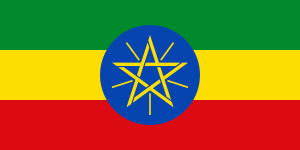Prime Minister of Ethiopia
| Prime Minister of the Federal Democratic Republic of Ethiopia የኢ.ፌ.ዴ.ሪ ጠቅላይ ሚኒስትር | |
|---|---|
 Emblem | |
 Flag of Ethiopia | |
| Residence | Menelik Palace, Addis Ababa |
| Appointer | President of Ethiopia |
| Term length | No term limit |
| Inaugural holder |
Habte Giyorgis Dinagde (Chief Minister) Makonnen Endelkachew (Prime Minister) |
| Formation |
1909 (Chief Minister) 1943 (Prime Minister) |
| Deputy | Demeke Mekonnen |
| Website | Prime Minister Office - Ethiopia |
 |
|---|
| This article is part of a series on the politics and government of Ethiopia |
|
|
Judiciary
|
The Prime Minister of Ethiopia is the head of the Ethiopian government and the most powerful figure in Ethiopian politics. Although the President of Ethiopia is the country's head of state, his powers are largely ceremonial; the Constitution explicitly vests executive power in the Council of Ministers, and names the Prime Minister as chief executive. The official residence of the prime minister, is Menelik Palace in Addis Ababa. The current Prime Minister is Abiy Ahmed of EPRDF, the 15th person to hold the position.
Following an election, the President nominates a member of the House of Peoples' Representatives to become prime minister after asking party leaders whom they support for the position. The nominee then presents a government platform and must receive a vote of confidence in order to become prime minister. In practice, the Prime Minister is usually the leader of the largest party in the House of Peoples' Representatives.
Origins and history
The heads of government of Ethiopia have been Chief Ministers (1909–1943), and then Prime Ministers (1943–present). Since 1995 Ethiopia follows a Parliamentary system of government.
The Prime Minister's position is stronger on paper than his counterparts in other parliamentary systems fashioned after the Westminster system. In most other parliamentary systems, the head of state or the head of state's official representative (i.e., the monarch or president or governor-general) is nominal chief executive, but in practice is bound to act on the advice of the prime minister. Thus, the head of state de facto holds a purely ceremonial position, while the prime minister is the actual head of government and executive branch. In Ethiopia, however, the Prime Minister is both de jure and de facto chief executive.
The prime minister is expected to become a member of the House of Peoples' Representatives within six months of beginning their tenure, if he are not a member already. He expected to work with other ministers to ensure the passage of bills through the legislature.
Role and power of the prime minister
After each election, the President of Ethiopia invites the leader of the majority party or coalition in the House of Peoples' Representatives as leader of the majority party to form a government at the federal level and exercise its powers. In practice the prime minister nominates the cabinet ministers.
The prime minister is also the commander-in-chief of the Ethiopian National Defense Force.
The prime minister, in consultation with the Cabinet, schedules and attends the sessions of the Houses of Parliament and is required to answer the question from the Members of Parliament to them as the in-charge of the portfolios in the capacity as Prime Minister of Ethiopia.
The prime minister represents the country in various delegations, high level meetings and international organisations that require the attendance of the highest government office.
Security
The bodyguards of the Ethiopian Prime Minister have been seen with the TAR-21 assault rifle.[1][2]
See also
References
- ↑ Archived February 8, 2015, at the Wayback Machine.
- ↑ "Ethiopia's Meles urges recognition of poll win". ethiomedia.com. 2010-05-25. Retrieved 2015-08-25.
External links
![]()
_(cropped).jpg)